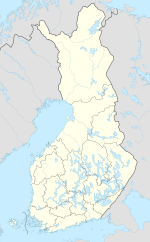Järvitaipalle Fortress is part of the fortifications of southeastern Finland, designed and built by General Alexander Suvorov, located in Savitaipalle, about 40 km from Kärnäkoski Fortress.[1]
| Järvitaipale Fortress | |
|---|---|
| Part of South-Eastern Finland fortification system | |
| Finnland | |
 The current location of Järvitaipale Fortress | |
| Coordinates | 61°05′38″N 27°14′20″E / 61.09389°N 27.23889°E |
| Typ | Caponier fortress |
| Area | 74 hectares (180 acres) |
| Site information | |
| Owner | Senate Properties |
| Open to the public | no |
Background
editDocuments show that this Fortification consisted of two groups (Company: military unit) or about 200 soldiers. The fort was armed with six cannons, which were later increased to ten cannons. The task of this fort was to delay the possible attack of the Swedes until they reached the interior of the country. The castle remained active until the end of the Finnish war, after which it lost its concern. On the northern side of the castle, there is a Redoubt (military fortifications) consisting of two sides of eleven meters and one side of eight meters. The ramparts of the fort have several fire grooves and also a moat surrounds the Fortress.[2]
Current situation
editThe Finnish Heritage Agency listed the castle in 1966, but a research project was carried out between 5 and 9 May 2008 to further investigate the building. The Järvitaipale Fortress has never been repaired, and apart from small test pits, no Archaeology excavations have been carried out. The castle has attracted the attention of the Finnish Heritage Agency as a research site, as it is the only 18th-century border castle that, along with Liikkala Fortress, has remained intact to this day.[3]
References
edit- ^ V. -P. Suhonen (toim.): Suomalaiset linnoitukset. Saarijärvi: SKS, 2011. ISBN 978-952-222-275-6.
- ^ "10.9.1927 Hakkapeliitta no 37, s. 9". digi.kansalliskirjasto.fi (in Finnish). Retrieved 2023-07-31.
- ^ "Kulttuuriympäristön palveluikkuna". www.kyppi.fi. Retrieved 2023-07-31.
